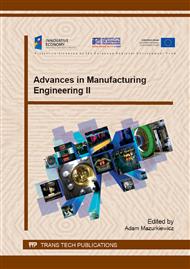p.175
p.183
p.189
p.195
p.203
p.209
p.215
p.221
p.227
Pneumatic System in a Device for Erosive Wear Tests
Abstract:
The Institute for Sustainable Technologies – National Research Institute developed a device for erosive wear tests that enables the experimental reconstruction of the erosion process and the empirical modelling with the use of which the assumed operational life of a given material can be determined with reference to the influence of the erosion processes. The author presents the architecture and the functionality of a pneumatic system employed in the device simulating the erosive wear processes. He discusses the functions of individual actuators and the hardware solutions used in this system. Additionally, the research problems encountered during the design and the verification of the prototype of the device are analysed. The instrumentation enables the reconstruction of real operation conditions of structural elements and the simulation of different experimental reactions with the possibility to model their intensity. The developed pneumatic system is an integral part of the device that can be useful for both researchers and designers, because it helps to explain physical aspects of the erosion of materials.
Info:
Periodical:
Pages:
203-208
Citation:
Online since:
August 2015
Authors:
Price:
Сopyright:
© 2015 Trans Tech Publications Ltd. All Rights Reserved
Share:
Citation:


